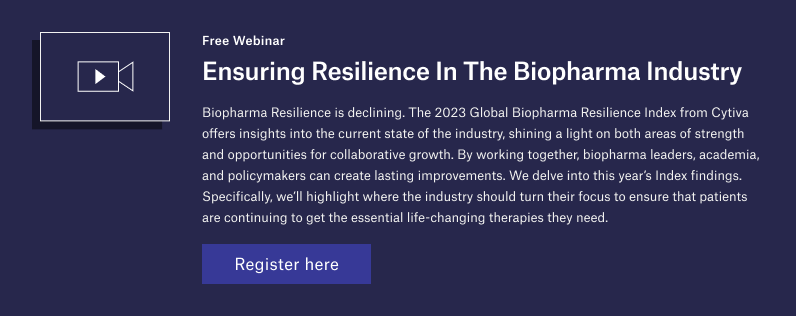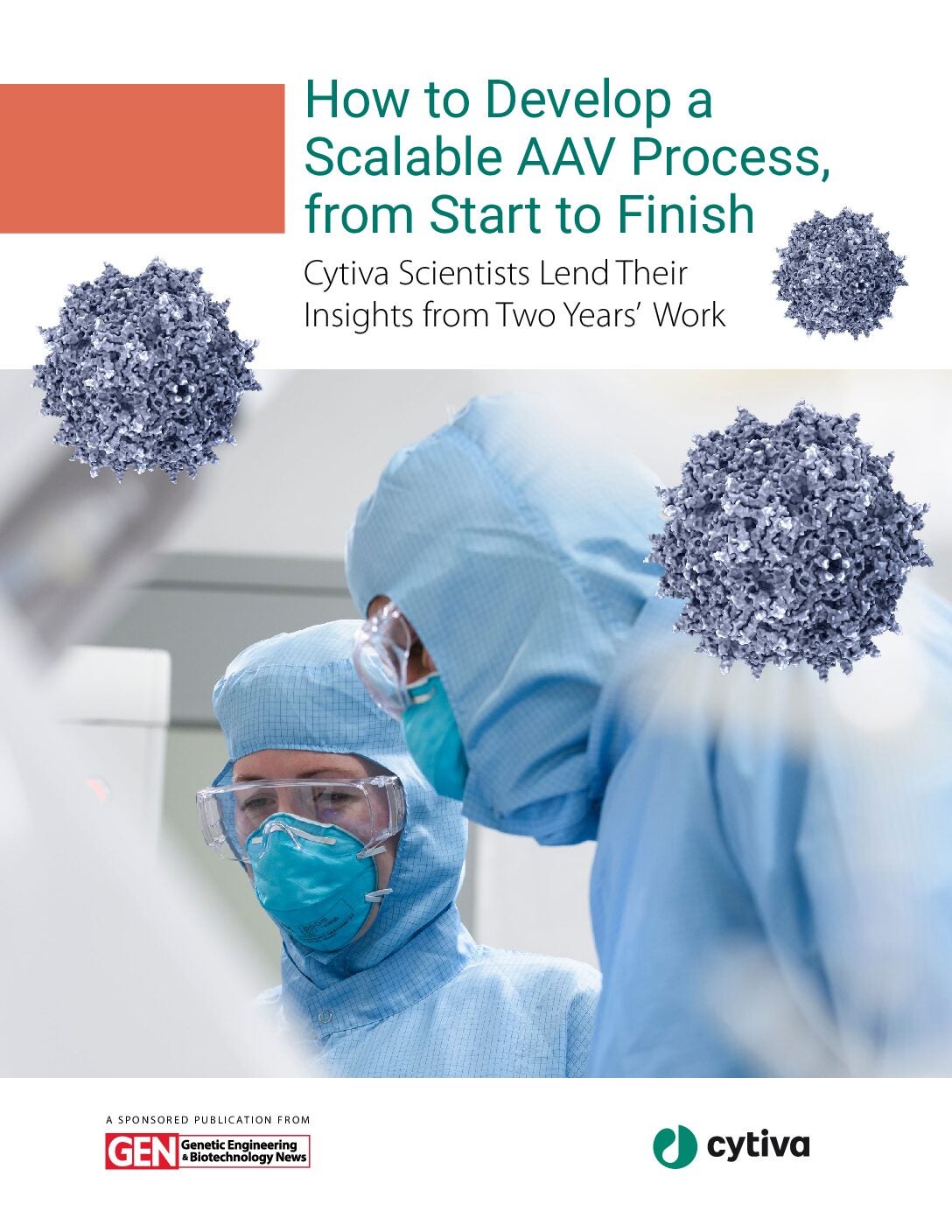
With the exciting promise of addressing previously unmet medical needs, the rapidly growing field of gene therapy has already begun to revolutionize patient treatment. The ability to create a genetic fix for certain cancers and other rare diseases has resulted in the launch of several innovative gene therapy drugs over the last few years, such as Kymriah™, Luxturna™, and Zolgensma™. Significant growth is expected to continue, with the FDA anticipating the approval of 10 to 20 cell and gene therapy products a year by 2025. This belief is supported not just by the clinical success rate of these drugs but also the current pipeline, which includes close to over 700 clinical trials within the gene therapy field, nearly doubling the amount only a few years ago in 2016 (400) (based on an internal analysis by GE Healthcare Life Sciences, 2010 to 2019).
A key component of gene therapy is the use of viral vectors for in vivo and ex vivo gene transfer, which are used in approximately 70 percent of cell and gene therapies under trial. Producing these gene delivery vehicles, whether they are used to carry a therapeutic gene to a target cell or to initiate cell transduction, relies on specialized skillsets and effective scale-up manufacturing strategies.
Uncertainties around the long-term durability of gene therapy development and manufacturing historically permeating the industry, though, have led to a field of drug companies and contract development and manufacturing organizations (CDMOs) that are unprepared for the market boom of regenerative therapies, resulting in a shortage of viral vectors to meet today’s demand.
Companies pursuing gene therapies, and even CDMOs that want to partner with them, must figure out a way to close the gap in viral vector production. For many, this means facing a build versus buy capacity decision that has long been a part of the biomanufacturing landscape, except procuring viral vector capacity comes with even more complexity and risk. That is why accelerating the production of your viral-vector based therapy requires you to understand not only the strategies available to address the viral vector manufacturing shortage but also how to select the most cost-effective solution for advancing the future of your next-generation therapeutic.
A world beyond mAbs: the complexities of gene therapy manufacturing
The biopharmaceutical industry has a long history with monoclonal antibodies (mAbs), beginning as a small portion of the overall biotherapeutic market to currently making up over 50 percent of it. Yet, the emergence of mAbs as therapeutics was not without setbacks. Early production efforts delivered low titers and poor purification yields, which made commercial manufacturing of mAbs costly and inefficient. A focus over time, though, on improving production processes eventually gave way to improved productivity, robustness and scalability, accelerating large-scale commercial supply.
The current state of viral vector manufacturing is reminiscent of the evolution of mAbs but with major differences. Viral vectors are much larger, more complex molecules and their production environments need to apply strict control of nucleic acid workflows in addition to the typical microbial contamination concerns. Viral vectors are also typically more expensive to manufacture than most mAbs, due to the requirement for an increased biosafety level classification (BSL-2 classification for most viral vectors compared to BSL-1 classification for traditional mAbs), which adds manufacturing and facility complexity and costs. In addition, most viral vector processes are not yet efficient. Starting product titers as well as total process recoveries are still quite low, just as they were for mAbs in the early years of production.
While the industry identified more efficient methods to manufacture mAbs with the highest levels of productivity, purity, safety and quality, those proficient in mAb production may not have enough understanding of or experience with gene therapy production. Compared to traditional mAb production, gene therapy production typically requires different skill sets, such as cell processing and viral processing. Experience and skills working with potentially infectious products in increased biosafety level environments are also needed.
The costs and complexities of manufacturing viral vectors as well as the expertise it requires have ultimately led to significant constraints within the CDMO industry when it comes to managing current demand. Delays in viral vector manufacturing through CDMOs can be more than 18 months, tying up drug companies’ multimilliondollar investments due to scheduling issues, process efficiencies, smaller batch sizes, training, and other issues. Companies that do not have the time to wait, as well as CDMOs that want to rapidly expand or increase their capabilities in order to alleviate these wait times, can either build the production capacity necessary or explore other solutions to ensure an uninterrupted supply of clinical and even commercial product.
The business case for build vs buy
Adopting a scalable and cost-effective production process for viral vectors is critical to meeting the demand for your gene therapy. As gene therapies continue to draw appeal from within the industry, it is possible more CDMOs will dedicate the training and facility space necessary for new customers entering this market. Some companies pursuing these drugs may have a business model that allows them to wait for a production slot with a qualified CDMO, while others may decide to build the infrastructure that can take them forward to full commercialization, securing supply for the future. The decision is dependent upon the business strategy. Are you looking for an early exit through an acquisition or a long-term partnership with large pharma? Are you going to invest in in-house production capacity or are you going to outsource production?
There are many factors that influence the make vs. buy decision. These include timeline, investment needs, production capacity needs, in-house capabilities and competencies, overall program control and intellectual property (IP) protection. The business case for outsourcing versus building your own capacity also depends on what segment of the gene therapy market you are targeting.
In vivo gene therapy, where the vector carrying the gene is the end product injected into the patient, predominantly uses the adenoassociated virus (AAV), putting this viral vector in especially high demand. There is also tremendous variability in scale within this segment, with batches ranging from 5 liters up to 2,000 liters. A viral vector manufacturing platform that can easily scale up as needed is difficult to achieve and maintain. The quantity needs for viral vectors in in vivo gene therapies are much higher compared to ex vivo gene therapies (gene-modified cell therapies), where cells are taken from the patient, genetically modified using viral vectors (Lentivirus and gamma Retrovirus), and then infused back into the patient. In this ex vivo gene therapy segment, the capacity needs are not as great, but supply issues are still observed due to the lack of available, cGMP-compliant viral vectors.
Larger companies with sufficient resources that are working on an in vivo gene therapy may choose to internalize production in order to mitigate the risk of a supply shortage as well as to maintain ownership of the core technology and intellectual property. However, smaller companies in this segment that want to position themselves for commercialization but do not have the resources or capital to build capacity or companies working on ex vivo therapies where building capacity may not be necessary will likely need or want to explore the outsourcing option. Unfortunately, for companies intending to commercialize their therapy, waiting for a CDMO is not a feasible or sustainable business model.
Speed to market is critical for most, if not all, biologics. This is quite relevant in the gene therapy segment as many gene therapies qualify for orphan drug status and/or fast track designation status, shortening the drug development timeline from 7 to 10 years (for traditional biologics) to 3 to 5 years, which creates even more pressure to decrease the production timeline.
A viable alternative
A fully integrated, flexible, and adaptable modular facility tailored to the unique production and business needs of viral vectors has emerged as another option to address the viral vector manufacturing shortage. This solution includes a turnkey bioprocessing platform that meets biocontainment requirements and can be fully commissioned and qualified in as little as 10 to 12 months, which is comparable to the amount of time you will likely wait for a production slot at a CDMO. These offer an alternative to stick-built facilities that allows you to be ready for commercialization while also gaining a strategic advantage by maintaining control of your process, program, and IP.
For many small and emerging companies with gene therapy manufacturing platforms that lack or have limited facility engineering and construction and commissioning and qualification experience and expertise, modular facilities provide a rapid, off-the-shelf, compliant solution. Modular facilities, such as the KUBio™ products, can include biomanufacturing services to keep your drug program on track by providing parallel cGMP manufacturing while you are building your facility. Training and education on your process and your production platform can also be provided to get you and your staff ready for when commissioning and qualification of the facility is complete.
For small and emerging companies, predesigned modular environments can simplify capacity expansion plans where there are often misunderstandings around what it takes to meet regulatory requirements. Proper design and efficient workflows and ease of use in Grade B, C, and D environments become of paramount importance when manufacturing gene therapies. Modular environments that include integrated single-use processing lines and defined culture media and process buffers can reduce risk and variability.
With much of the equipment in existing facilities today designed for traditional biologics, new technologies to support increased viral vector titers and process recoveries will undoubtedly emerge as the industry continues to explore and mature in this space. You must be aware of these advancements and have a manufacturing platform and a facility that is flexible and adaptable, so you can incorporate and integrate these new technologies.
Making your decision
Identifying the best option for your business model and market strategy is critical to your success. Your conversations and planning should start early so that every step is carefully executed and drives you toward the most efficient path towar commercialization. If you do decide to use a CDMO for your gene therapy production, are you willing to potentially wait for a production slot? Should you outsource segments of your process development and early phase clinical production to a CDMO and then build your own internal capabilities when you know that the probability of success is higher?
Conversely, can you take on the total cost of ownership of building and staffing a facility that can meet and maintain your productio and supply requirements? In some cases, the molecule may be so novel or the process so complex that finding a CDMO with the appropriate expertise and capacity to suit your needs is not possible, leaving you no choice but to explore your own in-house facility options. Whichever option you choose, make sure you have the appropriate internal program management support and relevant expertise to keep your development program moving forward on time and effectively. This is essential, especially when designing, building, and commissioning a new facility.
When looking for a CDMO partner, determine what their experience is with your application and bioprocessing platform capabilities. In addition to having the right expertise, do they have the appropriate level of program management required to oversee your program and ensure each milestone is sufficiently met on time? Program management is different than the project management services that might be required for delivering pieces of the overall solution. Ultimately, strategic relationships with CDMOs and collaborative program management can ensure the path to commercialization meets your end goal.
Overall, entering the gene therapy space makes you part of a medical revolution that is being accelerated by some of the most extraordinary advances in science the industry has ever seen. At the same time, manufacturing challenges and capacity constraints may require years of experience and expertise to overcome. Make sure the solution you choose for viral vector manufacturing has the capabilities to prepare you for any potential threats to the viability of your product and can secure your place in this growing market for years to come.
For more articles from Cytiva click HERE




